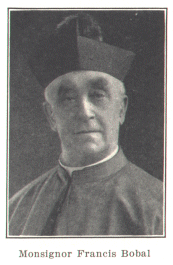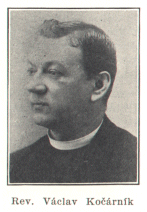 |
Catholics |
This is a NEGenWeb Project web page
and is presented as part of the
MARDOS Memorial Library Collection.
Catholics
|
Although the Catholics had a hard struggle in the early days, they have reason to feel satisfied with what they have accomplished. As stated before, for a long time they had but one Catholic paper. The first five Czech papers published in this country were non-Catholic. In 1867 the first Catholic paper was launched in Chicago (Katolicke Noviny) but existed only half a year. Then followed nine papers similar to the first (neutral or anti-Catholic) and it was not until 1872 that the Catholic weekly Hlas (still being published) was founded in St. Louis, Missouri. Thus, in the matter of publicity, the liberals had the start. With practically no papers of their own, with almost no priests and churches, and the pioneers everywhere struggling for a bare living, it was but natural that the beginning was hard and slow. But the devout could not be long without the support of their faith. Masses were said in private homes, in public-school buildings, in a court house, as the subsequent record shows. In Howard County they met for worship before a cross driven into the ground. As soon as they could get together a few dollars, they built simple frame churches, in the eastern part and in western Nebraska constructed log and sod churches. These first crude buildings are being replaced by large and handsome structures and the same is true of rectories and schools. Some Catholic communities also have their halls, but we do not list them here. We have included the Liberals' halls to show what they have done in that direction, as a contrast to what Catholics have accomplished in building churches. PIONEER PRIESTS 
The first resident priest in Nebraska was Rev. later Monsignor Francis Bobal, although he did not have a Czech parish, for he was assigned to Plattsmouth in 1872, when there were no such parishes. Later he was assigned to St. Philomena's Cathedral in Omaha, and still later to Falls City, where his health failed and in 1876 he left our state. Monsignor Bobal was born September 16, 1845, in Luzkovice, Moravia, was ordained in Louvain, Belgium, in 1871, and in the latter part of that year came to Omaha. While in Nebraska he did missionary work among the scattered people, together with Rev. Francis Sulak, who was a missionary here altogether, not being connected with any parish. Rev. Bobal died in Chicago, Ill., December 20, 1927. Rev. Francis Sulak was born in 1825 in Nacice, Moravia, ordained in France and lived there four years, then for twenty years did missionary work in Europe. He was of the Jesuit Order. In 1865 he was sent to the United States and remained here until August 19, 1907, when he went to Cracow, Galicia, where he died January 28, 1908. He spoke eleven languages and was a naturalist and chemist. His large and valuable collection of botanical and mineral specimens is in the St. Ignatius College, Chicago, Illinois. The first mass served for Czechs in Nebraska was in the home of Joseph Simanek, near Prague, Saunders County, in September, 1871, by Rev. Sulak. For a long time there was a country postoffice there, called at first Plzen after the city in Bohemia of that name. Later the name was changed to Plasi, because it caused confusion in mail delivery with Pilger, Stanton County. Frank Kubik, a pioneer, and then postmaster, asked that the name be changed to Plasi, after the town in Bohemia. This parish is still known by the name of Plasi, although the postoffice has been discontinued for Prague. Rev. Bobal alternated with Rev. Sulak, serving also in the school house, and although the church was not built until 1878, it is in truth the oldest Czech parish in the state. A more detailed history is found in the list of parishes. As far as recorded, the next mass served in a private home was in the sod house of Joseph F. Sindelar, in Colfax County, on Christmas Day, 1871, by the members of the assembly themselves. Several pioneers had settled there on Maple Creek in 1870, as recorded in the history of Tabor parish. These people continued serving mass for themselves for some time before the missionaries and priests came. Thus for several years Catholics worshipped in homes or buildings allowed them for that purpose. In 1877 Bishop O'Connor of Omaha sent Rev. Groenbaum to Europe, to enlist the services of German and Czech priests, and a call was issued in the papers of Bohemia for priests needed in rapidly forming settlements. Several answered it and thus an impetus was given to the building of churches. Those who came in that year were: Rev. John A. Blaske (Blaschke) who was assigned to the Czech and German parish of Olean, Colfax County. Rev. Blaske was born January 15, 1844, in Horni Dobrouc near Lanskroun. Having entered upon his theological studies, he resigned in order to marry. Upon the death of his wife, he re-entered the seminary in 1876 and in 1877 came to Nebraska to do missionary work with Rev. Joseph Hovorka (who was assigned to the parish of Abie) and a student of theology F. Smutny, who was ordained in Chicago, August 17, 1877, and was assigned to Wilber. Rev. Blaske was transferred to LaCrosse, Wisconsin, in 1881 and died there February 15, 1901. Rev. Smutny stayed in Wilber but a few months, for he was afflicted with tuberculosis and died in 1879 in Minnesota. Rev. Hovorka's biography is given in the history of Abie parish. About that time or just a little later came the following: 
Rev. Vaclav Kocarnik (biography given in the history of St. Wenceslaus parish, Omaha). Rev. Cyril Angustinsky, assigned to Columbus and assisting throughout Colfax County. He was born in Brusperk, Moravia, March 21, 1851, ordained in St. Louis, Missouri, July 25, 1875, died in Veseli, Minnesota, January, 1901. Rev. F. Tuerk, assigned to Olean June 8, 1882. He was born April 9, 1827, in Brezova, Moravia, ordained in Olomouc, Moravia, August 1, 1852, came to the United States in June, 1881. There is no record of his death. Rev. Francis Pold came in 1883 to Colfax County, serving later in Saline County and probably elsewhere, wherever necessary. He was recalled to Bohemia in 1888. With him came a lay brother of the Jesuit Order, John Kramar. Rev. Siegfried Klima, O. S. B., was another pioneer priest, of whom, however, no other biographical records are available. During the late seventies and early eighties Colfax County was the scene of greatest activity, for within six years six churches had been built. It was probably for that reason that there was some agitation in favor of erecting a monastery of the Bohemian Benedictine Order in Plasi or Cedar Hill, Saunders County. Bishop O'Connor had obtained the assistance of two Benedictine fathers from Pennsylvania, Rev. Vaclav Kocarnik and Rev. Siegfried Klima, but the plans were not approved and later the monastery was established in St. Procopius' parish, Chicago. In 1877 several Franciscan fathers arrived from St. Louis, Missouri, to take charge of the parish in Columbus, where and whence they served German, Polish and (when necessary) Czech elements. The first church built by Czechs was in conjunction with Germans, in the German-Czech parish of Olean, Colfax County, in 1874, lumber having been brought from Fremont, forty miles distant. In 1875 and 1876 Rev. Sulak used to come to cheer and encourage the pioneers stricken by the grasshopper plague. Rev. Blaske was the first resident priest, followed by Rev. Tuerk, during whose time the Czech parishioners separated from the German and formed the parish in Dodge, where a church was built in 1884 and dedicated by Rev. Tuerk. The first wholly Czech church was built in Abie, Butler County, in 1876. In 1877: churches in Omaha (St. Wenceslaus), Appleton and Warsaw. In 1878: Plasi, Heun and Wahoo. In that year erection of the church in Wilber was begun, but lightning struck it and the building was sold for other purposes. These then were the beginnings of the Catholic Church among Czechs in Nebraska, who worshipped at first in small even rude buildings, which have gradually been replaced by better ones, that in Wahoo being the finest at present. The church in Brainard held that distinction for twenty years. |
| Back | Table of Contents | Next |